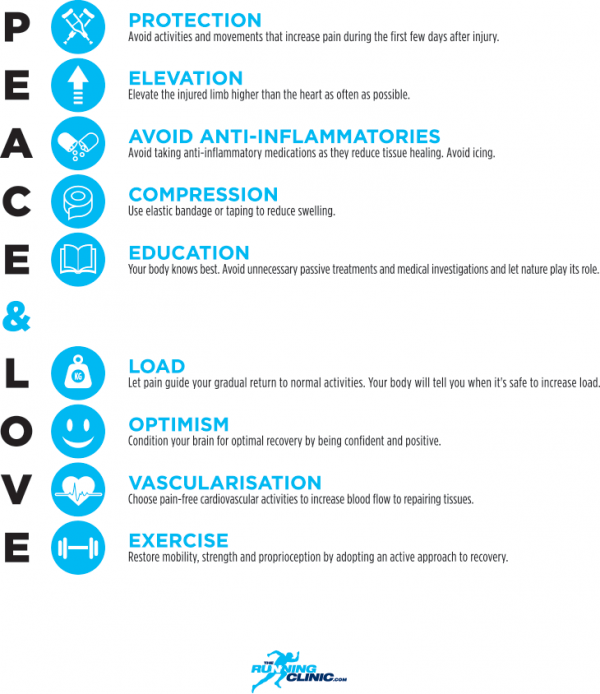How do you decide to apply ice or heat to an acute injury, pain or swelling? You’re probably familiar with the RICE acronym for managing a strain or sprain. Or maybe you’re more familiar with the previous version, ICE, or later versions, PRICE or POLICE?
These acronyms help guide us decide on the application of ice or heat in the immediate care or first aid for soft tissue injuries and other techniques to manage an acute injury. But what about in the later phases of tissue healing? Once the swelling and pain has subsided? This is why we prefer to use the PEACE & LOVE acronym.
Use PEACE in the immediate aftermath of an injury and the following 1 to 3 days.
P – Protect
Limit the movement of the injured tissue to lessen the risk of making the injury worse and minimise bleeding. Your acute pain response is guiding you here. Anything that causes increased pain in the injured tissue during this time is your bodies warning to stop and slow down.
E – Elevate
When you can, elevate the injured tissue above the level of your heart. Though evidence is limited, there is low risk of using this technique to help fluid drain away from the injury.
A – Avoid anti-inflammatory modalities*
Inflammation is your bodies response to start repairing injured tissue. This is (most often) the swelling you see with injury and we want to support this process.
The use anti-inflammatory medications (NSAIDs), particularly in high doses, and even the application of ice can stop or reduce inflammation. This may negatively affect long-term tissue healing by disrupting blood vessel growth, preventing the restoration work of blood cells and hindering scar tissue formation.
Ice can be analgesic (reduces pain), but we have no high-quality evidence that it helps with healing, in fact there is a risk it may obstruct optimum healing. We advise on the use of other analgesics in place of ice if need be.
C – Compress
Apply an external compression, taping or bandage or wrap, if needed or preferred and especially if there is bleeding. Though evidence is conflicting, there is support for compression to reduce discomfort and improve quality of life.
E – Educate*
Being active in your recovery and becoming educated on the management of your injury is the best thing you can do to align your expectations, reduce your risk of chronic pain, over-treatment, unnecessary treatment (manual therapy, injections, surgery), and reduce your healthcare costs.
Proper and successful treatment can take time and effort on your part. Unfortunately, there is no magic-cure or silver-bullet. Be wary of anyone offering you a quick fix!
Use LOVE for the ongoing management of your injury in the sub-acute and chronic phases of tissue healing.
L – Load
Resume your normal activities as soon as pain and symptoms allow you to. You should load the injured tissue appropriately and early on to promote strong tissue repair, remodelling and tolerance. Your injury should not become that “weak ankle” or “dicky knee” that becomes an ongoing hinderance. Loading early can help avoid this, in the past we’ve likely been too protective.
O – Optimism*
Being positive, hopeful and realistic in your recovery, as well as being active in your recovery and educating yourself, all lead to better outcomes.
Being pessimistic, fearful of movement or pain, or catastrophising your injury can all be barriers to a full and successful recovery. These psychological factors explain the difference between why seemingly the same injury can affect two people very differently.
V – Vascularisation
Increasing blood flow through the injured tissue by engaging in pain-free cardio exercise within a few days assists tissue healing. As well as boosting confidence and motivation.
E – Exercise*
Exercise is the best way to increase strength, mobility and balance after injury. This point is about extending treatment beyond the injury tissues and the diagnosis. It is about treating “the person with the injury rather than the injury of the person”! We want to support strong long-term outcomes making sure this injury does not become something you carry with you for the rest of your life. We have different options available
PEACE and LOVE underscore the importance of moving beyond using ice and heat and looking at short-term get out of pain goals and instead moving towards active patient participation, education, and consideration of psychosocial factors in optimising long-term recovery outcomes. We have multiple options available at Trident to help support you in achieving these long term goals, from Chiropractic care to rehabilitation classes.
* If you take anything away from this blog, we’d like it to be these points!

